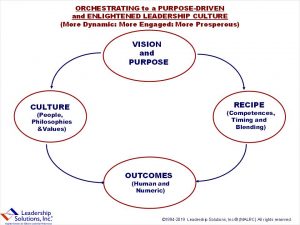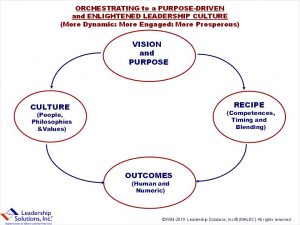by Peter A. Arthur-Smith, Leadership Solutions, Inc.®
‘Culture change is the modification of a society (or organization) through innovation, invention, discovery or contact with other societies (organizations)’ – Merriam-Webster Dictionary
 |
Anyway, you realize that your command-and-control culture is holding your enterprise back: very limited innovation, little day-to-day initiative, productivity is lacking, your organization’s growth is creeping along, and so forth. So what’s an organization supposed to do in such circumstances? Revamping cultures is an enormous challenge. As can be seen from the adjacent pictograph, it is determined by your organization’s Vision-Purpose at any one moment in time. Since it takes time for your vision-purpose to take hold and solidify, so it takes time for your culture to become part of your enterprise’s life-blood. Culture is also influenced by the recipe you decide to pursue – direct or third-party connections with customers or beneficiaries, a regional or national approach, product or service offerings, and so on.
One of your earliest initiatives, after giving the matter some serious thought and discussion with your key team, is to consider your enterprise’s options. These could include: bringing-in a turnaround specialist, revamping your key team, merge with a competitor, wait for a crisis, set-up a breakthrough team, or seek a more enlightened buyer. Since it’s not always easy to be objective about your best option, it’s probably best to take your organization or advisory board or key team through an Option Solving exercise as portrayed at www.optionsolving.com. Then, when it comes to decide, you should draw upon your board’s collective wisdom through a confidential ballot. If it then turns out that their choice is ‘for a turn-around specialist,’ then – seriously – you should negotiate an early, graceful departure package to help everyone.
Now let’s take a look at their-your other choices:
» Revamping Your Key Team – With such a choice, you should take the time to consult with as many board members as you can and listen carefully to their insights about your key team members. Which ones may be reinforcing the command-and-control culture and why? Once you gain a decent understanding of their perspective, some of which will likely confirm your own intuitions, then you should then set about making team changes in a timely but sensitive manner.
The moment you have completed those changes, you can then take your revamped team through a Strategic Framing (SF) exercise as soon as possible – consider asking for a copy of Appendix G in our forthcoming book. Use this SF to re-gear your organization’s principles and values toward an Enlightened Leadership (EL) culture. The moment this is complete you should form a breakthrough team (BT), involving at least two members from your key Strategist team, so they can reinforce the sentiments of their earlier SF session with members of that BT.
» Merging with Another Organization – Since this will most likely be with a competitor, hopefully you will choose one which has a close resemblance to an EL culture. You should then be explicit in your intentions from the get-go with your new potential partner. You will both quickly come to an understanding about who will be Visionist for the new merged entity. If it happens to be you, then you can lead discussions on which Strategists from both entities will become the new Strategist team of six. Alternatively, if your new partner is chosen, he/she will lead the merged grouping of six. Either way, once the new Strategist team is formed, you, they and the new Visionist should return to a Strategic Framework (SF) exercise once more and proceed accordingly.
» Wait for a Crisis – It’s likely, if you and your team are taking action, that your organization is already in crisis at this point. Organizations, like people – because they are comprised of people – are often reborn in such situations. It could well provide the pretext to shake out your Strategist team and replace them with EL Strategists – see forthcoming book chapters 7-10. Once your revised team is in place, you are again in a position to refresh your Strategic Framework (SF) – which includes setting a fresh vision and purpose – along with resetting its Guiding Principles and Values. Then proceed as outlined previously.
» Setting up a Breakthrough Team – This was covered in our immediate-past Phase 5 article.
» Seek a more Enlightened Leadership Buyer – Such a move is one step removed from a pure competitor merger. It’s where you will help attract a suitable buyer – competitor or an akin industry player – make clear your intentions, and then step-aside the moment the deal is signed. You will be helpful wherever you can, but then allow for the chips to fall where they may. The new owners will now likely rebuild the organization, merge it into their own, or just turn it around with a fresh culture – where possible.
Clearly there may be other options, too, although the ones covered are the most likely ones. It’s to be hoped that you have a decent organization or advisory board to assist you make the right choice. Whichever option you choose, you should all come to terms with recognizing that any culture transformation will take time – more than likely a year or two before you begin to see some clear light at the end of the tunnel – you will be lucky not to experience a few set-backs along the way.
This is because people don’t change overnight. It usually takes up to nine months before you begin observing lasting changes. If you try to move too fast, other than immediate changes with your Strategist team, there may be unintended consequences – valuable players are poached away, customers go elsewhere, capable suppliers fall away, alliances break down, and so on. Building a smooth transition takes time and patience – that will be your leadership test, or for the person who replaces you. Even then culture change has to be pursued fairly rigorously with great persistence…it can be exhausting and rewarding at the same time.
To learn more about envisioning and decision clarity, talk with:

